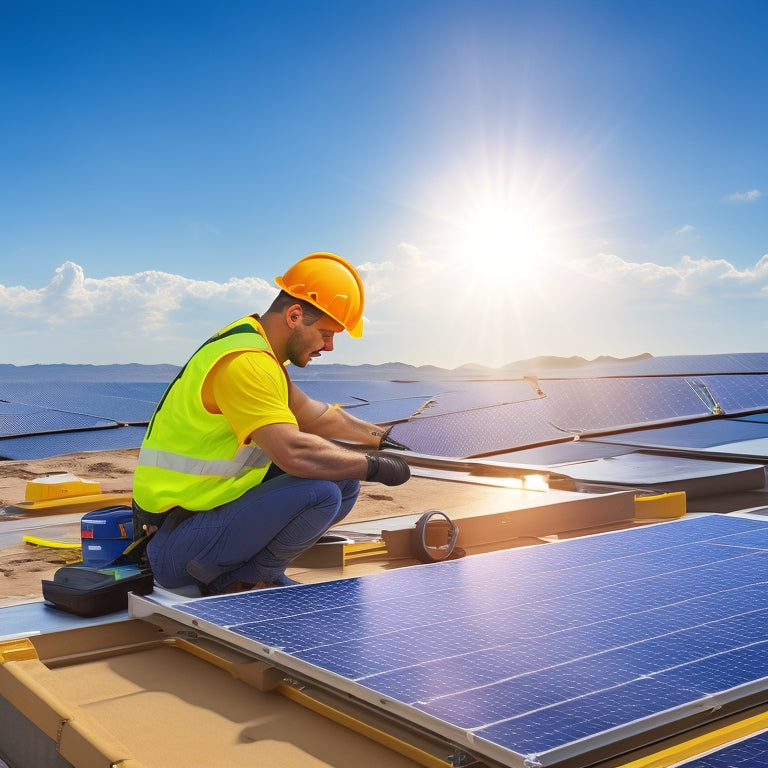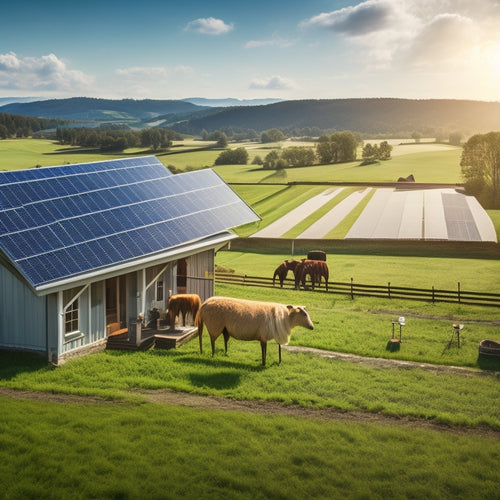
10 Essential Solar Panel System Maintenance Tips
Share
You can greatly extend the lifespan and efficiency of your solar panel system by staying on top of routine maintenance tasks. Inspect your panels regularly for debris buildup and clean them safely using appropriate tools and products. Check and tighten loose connections to guarantee peak performance, and verify your inverter's efficiency and functionality. Monitor your energy output closely to identify patterns and anomalies, and inspect your tracking systems for peak performance. By following these essential maintenance tips, you'll be well on your way to maximizing your system's performance - and that's just the beginning of optimizing your solar panel system's potential.
Key Takeaways
• Regularly inspect and clean solar panels to maintain energy output and prevent debris buildup.
• Check and tighten loose connections to ensure peak performance and electrical safety.
• Monitor energy production closely to identify patterns and anomalies, and set energy output goals.
• Inspect tracking systems and clean them regularly to ensure optimal performance and address signs of wear and tear.
• Use thermal imaging inspections to detect potential issues, identify hotspots, and pinpoint loose or corroded connections.
Inspect Panels for Debris Buildup
Regularly inspecting your solar panels for debris buildup is crucial, as leaves, dust, and dirt can reduce their energy output by up to 25%. You'll want to check your panels frequently, especially during periods of high dust accumulation or after severe weather events.
Environmental factors like wind, rain, and snow can all contribute to debris buildup, so staying on top of inspections is vital.
When inspecting your panels, look for signs of debris accumulation, such as leaves, branches, or dirt. Check for any obstructions, like bird droppings or pollen, that can reduce energy output. Additionally, examine the panels' frames and mounting systems for any signs of damage or wear.
Clean Panels Regularly and Safely
Every six months, you should clean your solar panels to remove accumulated debris and maintain their energy output, as neglecting this task can lead to reduced performance.
Cleaning your solar panels regularly is important to guarantee maximum energy production. When cleaning, use a soft-bristled brush or a specialized solar panel cleaning tool to avoid scratching the panels. It's vital to use panel cleaning products specifically designed for solar panels, as regular cleaning products can leave streaks or residue that can reduce energy output.
Additionally, consider water conservation methods when cleaning your solar panels. Using a hose with a spray nozzle can help conserve water while still effectively cleaning the panels. Avoid using high-pressure washes, which can damage the panels or their mounts.
It's also important to clean your solar panels during the cooler part of the day to prevent water spots from forming. By cleaning your solar panels regularly and safely, you'll be able to maintain their energy output and ensure your solar panel system operates efficiently.
Check and Tighten Loose Connections
To guarantee your solar panel system's peak performance, can you afford to overlook the connections that hold it all together? Loose connections can lead to electrical safety hazards, reduced energy output, and even system failure. Regularly inspect and tighten connections to make sure your system operates at its best.
| Connection Type | Tightening Schedule |
|---|---|
| DC connectors | Every 6 months |
| AC connectors | Every 12 months |
| Grounding connections | Every 12 months |
| Inverter connections | Every 6 months |
| Mounting hardware | Every 12 months |
When checking connections, look for signs of wear, corrosion, or damage. Clean connections before tightening to guarantee a secure fit. Remember, proper connection maintenance is vital for electrical safety and connection durability. A well-maintained connection ensures a reliable and efficient energy supply. Don't risk your system's performance; make connection checks a regular part of your maintenance routine.
Verify Inverter Functionality Regularly
You've confirmed your solar panel system's connections are secure, now it's time to verify that the inverter, the brain of your system, is functioning as it should, converting DC power into usable AC energy efficiently.
Regular inverter checks guarantee your system operates at peak performance, providing reliable power and minimizing energy losses. Check the inverter's display screen for any error codes or alerts, and review its operating parameters, such as voltage, current, and temperature.
Verify that the inverter's efficiency is within the manufacturer's specified range, as a decline in inverter efficiency can greatly impact your system's overall power reliability. A well-maintained inverter ensures that your system generates power consistently, reducing the likelihood of unexpected downtime.
Monitor Energy Output Closely
As you monitor your solar panel system's energy output closely, you'll want to track energy production trends to identify patterns and anomalies. By doing so, you'll be able to pinpoint performance issues and take corrective action to optimize your system's energy output.
Track Energy Production Trends
Your solar panel system's energy production trends can reveal valuable insights into its overall performance and potential issues. By tracking energy production trends, you can identify patterns and anomalies that may indicate maintenance needs or potential upgrades.
Energy forecasting is a critical aspect of tracking energy production trends, as it helps you anticipate and prepare for fluctuations in energy output. This involves analyzing historical data to predict future energy production, taking into account factors like weather patterns, seasonal changes, and system degradation.
Conducting trend analysis is also essential to understand your system's performance over time. This involves monitoring key performance indicators like energy output, voltage, and temperature to identify areas for improvement. By analyzing these trends, you can optimize your system's performance, identify potential issues before they become major problems, and make data-driven decisions to maximize your system's energy output.
Identify Performance Anomalies
One key aspect of maintaining peak solar panel system performance is to closely monitor energy output for any signs of anomalies, as even slight deviations from expected levels can indicate underlying issues. To do this, you'll need to analyze your system's data to identify any anomalies. This involves collecting and analyzing performance metrics, such as energy output, voltage, and current.
| Date | Energy Output (kWh) | Performance Metric (%) |
|---|---|---|
| 2022-01-01 | 450 | 95 |
| 2022-01-05 | 420 | 90 |
| 2022-01-10 | 380 | 80 |
| 2022-01-15 | 410 | 92 |
| 2022-01-20 | 390 | 85 |
Set Energy Output Goals
To maximize your solar panel system's performance, you need to set realistic energy output goals, which involves closely monitoring energy output to make sure it aligns with your expectations. By doing so, you'll be able to identify potential issues and make adjustments to optimize energy production. Setting energy targets helps you stay focused on achieving peak performance and ensures you're getting the most out of your system.
When setting energy output goals, consider factors like your system's size, local weather patterns, and shading issues. Establishing specific, measurable, achievable, relevant, and time-bound (SMART) goals will help you stay on track. For instance, you might set a goal to increase energy production by 5% within the next quarter.
Regularly monitoring your system's performance will help you identify areas for improvement and make data-driven decisions to reach your energy targets.
Trim Trees and Manage Shading
As you maintain your solar panel system, it's important to address shading issues caused by nearby trees.
You'll need to analyze the shading pattern to identify which trees are obstructing sunlight and create a pruning schedule to minimize their impact.
Shading Pattern Analysis
By analyzing the shading pattern on your solar panel system, you can identify areas where tree trimming or relocation of obstructing objects can greatly enhance energy production. A thorough shade analysis will help you pinpoint the specific times of day and year when shading is most significant. This information is vital in optimizing your system's performance.
To conduct a shade analysis, you'll need to assess the orientation and proximity of surrounding trees, buildings, and other obstructions. Take note of the time of day and year when shadows fall on your solar panels.
This data will enable you to create a pattern optimization strategy tailored to your unique situation.
Tree Pruning Schedule
Based on your shade analysis, create a tree pruning schedule to systematically trim trees and manage shading, ensuring peak energy production from your solar panel system. This schedule will help you prioritize which trees to prune and when, ensuring that your solar panels receive maximum sunlight.
When developing your pruning schedule, consider the following tree care strategies: prune trees during their dormant season to minimize stress, remove crossing branches to promote healthy growth, and make clean cuts to prevent damage.
It's also essential to follow pruning best practices, such as pruning no more than 25% of the tree's foliage in a single year and avoiding pruning during extreme weather conditions.
Regular pruning won't only improve energy production but also maintain the health and aesthetic appeal of your trees. By incorporating these strategies into your tree pruning schedule, you'll be able to optimize your solar panel system's performance while maintaining a beautiful and healthy landscape.
Inspect and Clean Tracking Systems
You should routinely examine your tracking system to make sure it's operating at its best, as even slight misalignments can have a notable impact on energy production. A well-maintained tracking system is vital for peak solar efficiency, as it guarantees that your solar panels are always aligned with the sun.
When inspecting your tracking system, look for signs of wear and tear, such as loose bolts or corrosion, and address them promptly. Also, check the system's alignment and make adjustments as needed.
Cleaning your tracking system is equally important. Debris and dirt can accumulate on the system's sensors and motors, affecting its performance. Use a soft-bristled brush to gently remove any debris, and avoid using harsh chemicals or abrasive materials that could damage the system.
Check for Rodent Infestations Regularly
When checking your solar panel system, you'll want to regularly inspect for signs of rodent infestations, as these pesky critters can cause significant damage.
You'll need to look for signs of rodent activity, such as gnaw marks, droppings, or burrows, which can indicate hidden nests and tunnels.
Rodent Damage Signs
How often have you inspected your solar panel system's wiring and electrical components for signs of rodent damage or gnaw marks? Regular checks are essential to prevent costly repairs and maintain your system's peak performance. Rodent behavior analysis reveals that these pests often target soft materials like insulation, wires, and electrical connectors.
Look for signs of gnawing, chewing, or biting on cables, connectors, and other components. Check for droppings, burrows, or nesting materials around the system.
To prevent rodent infestations, incorporate wildlife exclusion methods into your maintenance routine. Seal all entry points, including holes and gaps, with rodent-proof materials like steel wool or expanding foam. Trim nearby vegetation to reduce shelter and food sources for rodents. Regularly clean up debris and food waste around the system to discourage rodent activity.
Hidden Nests and Tunnels
During routine inspections, meticulously search for hidden rodent nests and tunnels near your solar panel system, as these elusive signs can indicate a larger infestation issue. Rodents often create hidden habitats in dark, secluded areas, making it crucial to inspect your system thoroughly. Look for signs of rodent activity, such as burrows, gnaw marks, or droppings, around the perimeter of your solar panel system.
| Rodent Behavior | Wildlife Habitats |
|---|---|
| Gnawing on wires and materials | Burrows under solar panels |
| Creating hidden nests and tunnels | Using solar panels as shelter |
| Leaving droppings and urine stains | Exploiting food sources nearby |
Chewed Wire Insulation
Regularly inspect your solar panel system's wiring for signs of rodent damage, as chewed wire insulation can lead to electrical shorts, fires, and system malfunctions.
Rodents, such as mice and squirrels, are attracted to the warmth and shelter of your solar panel system, and their behavior often involves gnawing on wires to wear down their teeth. This can cause wire damage, exposing conductive materials and creating a fire hazard.
When inspecting your system, look for signs of rodent infestation, such as droppings, gnaw marks, or burrows near wiring. Check for frayed or exposed wires, and inspect wire insulation for signs of chewing or damage.
If you notice any signs of rodent activity, take immediate action to repair or replace damaged wires and seal any entry points to prevent re-infestation. Remember, prevention is key – regular inspections can help prevent costly repairs and ensure your solar panel system operates safely and efficiently.
Perform Thermal Imaging Inspections
You can detect potential issues in your solar panel system by performing thermal imaging inspections, which involve capturing infrared images of the panels to identify hotspots and temperature anomalies. This thermal analysis technique is essential for identifying issues that may not be visible to the naked eye.
By using infrared scanning, you can pinpoint areas of high resistance, corrosion, or other defects that could be reducing your system's efficiency.
Some key benefits of thermal imaging inspections include:
- Detecting temperature anomalies that could indicate faulty or damaged components
- Identifying areas of high resistance or corrosion
- Pinpointing loose or corroded connections
- Detecting thermal anomalies in inverters or other system components
- Providing a non-invasive, non-destructive testing method
Schedule Regular Professional Inspections
For essential performance of your solar panel system, it's vital to schedule regular professional inspections with a certified technician who can identify and address potential issues before they escalate into major problems.
Regular inspections can help you avoid costly repairs, reduce downtime, and maximize your system operates at peak efficiency.
When selecting a technician, look for certification from reputable organizations, such as the North American Board of Certified Energy Practitioners (NABCEP), which guarantees they meet rigorous certification standards.
Consider investing in a maintenance contract, which can provide regular inspections, priority service, and discounted rates for repairs.
A well-maintained system not only generates more electricity but also increases its lifespan.
By scheduling regular inspections, you can rest assured that your system is running smoothly and efficiently.
Don't wait until it's too late – schedule your inspection today and optimize your solar panel system operates at its best.
Frequently Asked Questions
What Is the Ideal Tilt Angle for Maximum Energy Production?
'As you fine-tune your solar panel system, imagine a painter's canvas, where the ideal tilt angle is the brushstroke that brings maximum energy production to life - typically between 25-35 degrees, with seasonal adjustments and regional variations to take into account.'
Can I Clean Solar Panels With Soap and Water?
When you clean your solar panels with soap and water, make sure the water is deionized and the soap is mild, as harsh chemicals can compromise panel efficiency; otherwise, water quality won't be an issue.
How Often Should I Inspect My Solar Panel System?
You should inspect your solar panel system at least quarterly, incorporating daily schedules to monitor performance, and perform a thorough visual examination every 6-12 months to guarantee maximum energy production.
Can I Install Solar Panels on a Metal Roof?
You're wondering if you can install solar panels on a metal roof? Yes, it's possible, but first, verify metal compatibility and proper roof preparation, including a watertight seal, to guarantee a secure and efficient installation.
Are Solar Panels Covered Under a Home Warranty?
You should carefully review your home warranty policy to determine if solar panels are covered, as warranty limitations and policy exclusions may apply, potentially leaving you with unexpected repair or replacement costs.
Related Posts
-

Off-Grid Solar Solutions for Sustainable Farming
Off-grid solar solutions can revolutionize your farming operations by providing energy independence and significant c...
-

How Solar Panels Increase Property Value
Installing solar panels considerably increases your property value by improving energy efficiency and attracting eco-...
-

Solar Power Systems for Rural Properties
Solar power systems offer a reliable and efficient energy solution for rural properties, allowing you to gain energy ...


